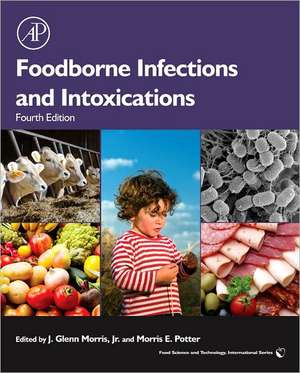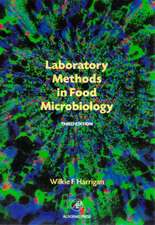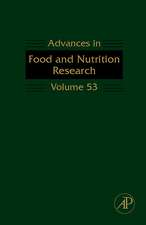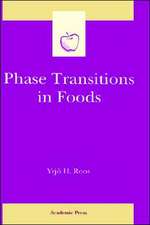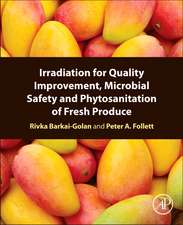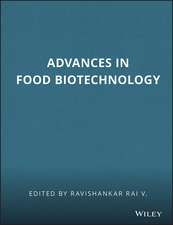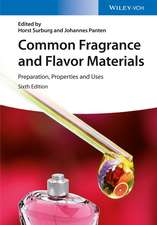Foodborne Infections and Intoxications
Editat de J. Glenn Morris Jr.en Limba Engleză Hardback – 24 mar 2013
- Provides a summary of the
Preț: 647.41 lei
Preț vechi: 681.48 lei
-5% Nou
Puncte Express: 971
Preț estimativ în valută:
123.91€ • 128.88$ • 103.84£
123.91€ • 128.88$ • 103.84£
Carte tipărită la comandă
Livrare economică 06-20 martie
Preluare comenzi: 021 569.72.76
Specificații
ISBN-13: 9780124160415
ISBN-10: 0124160417
Pagini: 568
Ilustrații: Illustrations
Dimensiuni: 191 x 235 x 33 mm
Greutate: 1.13 kg
Ediția:Revised
Editura: ELSEVIER SCIENCE
ISBN-10: 0124160417
Pagini: 568
Ilustrații: Illustrations
Dimensiuni: 191 x 235 x 33 mm
Greutate: 1.13 kg
Ediția:Revised
Editura: ELSEVIER SCIENCE
Public țintă
Professionals in food safety and the prevention of foodborne illness; food scientists, microbiologists, production supervisors, quality assurance directors, advanced undergraduate, graduate and professional students, health professionals, public health workers, and government advisors in related fieldsCuprins
Section 1: Foodborne Disease: Epidemiology and Disease Burden
1. Estimates of disease burden associated with contaminated food in the United States and globally
2. The Foods Most Often Associated with Major Foodborne Pathogens: Attributing Illnesses to Food Sources and Ranking Pathogen/Food Combinations
3. Microbial Food Safety Risk Assessment
4. Development of Risk-Based Food Safety Systems for Foodborne Infections and Intoxications
Section 2: Foodborne Infections: Bacterial
5. Pathogen updates: Salmonella
6. Clostridium Perfringens Gastroenteritis
7. Vibrios
8. Escherichia coli
9. Campylobacter
10. Yersinia
11. Listeria
12. Shigella
13. Streptococcal Disease
14. Aeromonas and Plesiomonas
15. Brucellosis
16. Cronobacter species (formerly Enterobacter sakazakii).
Section 3: Foodborne Infections: Viral
17. Noroviruses
18. Hepatitis A
19. Hepatitis E
20. Astroviruses as Foodborne Infections
21. Rotavirus
22. Sapovirus
Section 4: Foodborne Infections: parasites, and others
23. Toxoplasma gondii
24. Giardia
25. Cyclospora
26. Cryptosporidium
27. Mycobacterial species
28. Trichinella
29. Food Safety Implications of Prion Disease
Section 5: Intoxications
30. Clostridium botulinum
31. Staphylococcal Food poisoning
32. Bacillus cereus
33. Mycotoxins
34. Seafood Intoxications
35. Plant Toxins
Section 6: Policy and Prevention of Foodborne Diseases
36. Effects of food processing on disease agents
37. Food safety post-processing: transportation, supermarkets, restaurants
38. HACCP and other regulatory approaches to prevention of foodborne diseases
39. The legal basis for food safety regulation in the US and EU
1. Estimates of disease burden associated with contaminated food in the United States and globally
2. The Foods Most Often Associated with Major Foodborne Pathogens: Attributing Illnesses to Food Sources and Ranking Pathogen/Food Combinations
3. Microbial Food Safety Risk Assessment
4. Development of Risk-Based Food Safety Systems for Foodborne Infections and Intoxications
Section 2: Foodborne Infections: Bacterial
5. Pathogen updates: Salmonella
6. Clostridium Perfringens Gastroenteritis
7. Vibrios
8. Escherichia coli
9. Campylobacter
10. Yersinia
11. Listeria
12. Shigella
13. Streptococcal Disease
14. Aeromonas and Plesiomonas
15. Brucellosis
16. Cronobacter species (formerly Enterobacter sakazakii).
Section 3: Foodborne Infections: Viral
17. Noroviruses
18. Hepatitis A
19. Hepatitis E
20. Astroviruses as Foodborne Infections
21. Rotavirus
22. Sapovirus
Section 4: Foodborne Infections: parasites, and others
23. Toxoplasma gondii
24. Giardia
25. Cyclospora
26. Cryptosporidium
27. Mycobacterial species
28. Trichinella
29. Food Safety Implications of Prion Disease
Section 5: Intoxications
30. Clostridium botulinum
31. Staphylococcal Food poisoning
32. Bacillus cereus
33. Mycotoxins
34. Seafood Intoxications
35. Plant Toxins
Section 6: Policy and Prevention of Foodborne Diseases
36. Effects of food processing on disease agents
37. Food safety post-processing: transportation, supermarkets, restaurants
38. HACCP and other regulatory approaches to prevention of foodborne diseases
39. The legal basis for food safety regulation in the US and EU
Recenzii
"This reference is a collective effort edited by Morris and Potter, a public health consultant. The contributors mostly have backgrounds in food science, infectious diseases, and public health…Each chapter, when possible, contains sections on clinical features of infection, the microbiology of the organism, exposure pathways, and prevention and control." --Reference & Research Book News, October 2013
"The work is now in its fourth edition and presents the latest findings on diseases, infectious agents, methods of transmission and application of data on risk for the control of diseases transmitted through food. In particular, emphasis is given to the evaluation of borne pathogen and the development of approaches risk-based food safety and its regulations…" --Tecnica Molitoria (Milling Technique), September 2013 (in Italian)
"The text is an important source of information, necessary for reducing and eliminating infections and food-borne intoxications." --Industrie Alimentari (Food Industry), September 2013 (in Italian)
"The work is now in its fourth edition and presents the latest findings on diseases, infectious agents, methods of transmission and application of data on risk for the control of diseases transmitted through food. In particular, emphasis is given to the evaluation of borne pathogen and the development of approaches risk-based food safety and its regulations…" --Tecnica Molitoria (Milling Technique), September 2013 (in Italian)
"The text is an important source of information, necessary for reducing and eliminating infections and food-borne intoxications." --Industrie Alimentari (Food Industry), September 2013 (in Italian)
